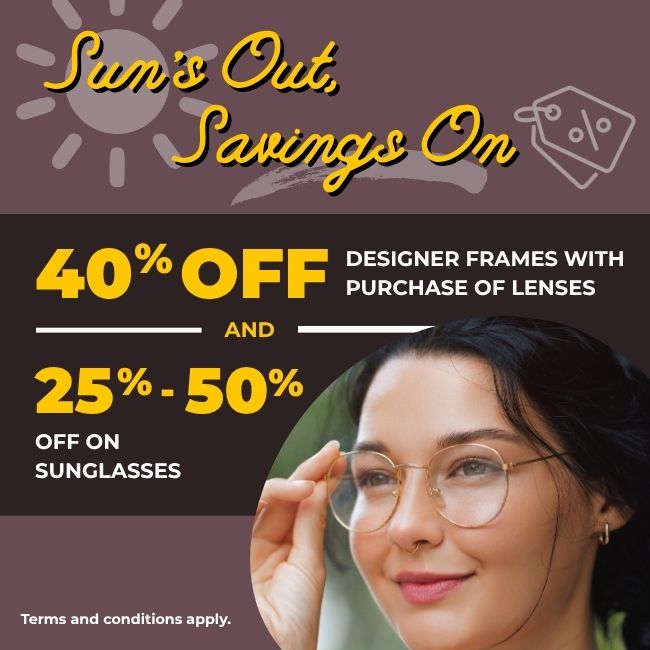Understanding Your Contacts
Contact lenses are a convenient option for patients who want to experience comfortable vision without relying on eyeglasses. There are many types of contact lenses, such as standard lenses for vision correction and therapeutic lenses for myopia control. But how do contact lenses work?
While contact lenses work similarly to eyeglasses, a few design differences make contacts unique.
How Lenses Refocus Light
Contact lenses work with the same basic principle as eyeglasses. Prescription lenses alter the way light enters the eye. People experience blurry vision when light focuses behind or in front of the retina instead of on the retina.
The retina is tissue located at the back of the eye. It contains photoreceptor cells that can distinguish between light or colour intensity:
- First, the light-sensitive cells gather information about what we’re seeing.
- Then, the retina processes the information and sends it to the optic nerve.
- Finally, the optic nerve transmits the visual information as electric signals to the brain.
Prescription lenses support the visual process by helping the photoreceptor cells receive light. When your optometrist examines your eyes during a vision test, they determine the amount of correction needed to refocus light.
Myopia
Myopia (nearsightedness) is when light focuses in front of the retina. The condition occurs when the eyeball shape grows too long or the cornea is too steeply curved. As a result, people with myopia experience blurry distance vision.
Generally, contact lenses for myopia are thicker on the outer edges and thinner in the middle. The lens reduces focusing power to help light reach the back of the eye.
Multifocal contact lenses for myopia feature 2 sections within the lens, usually shaped like a bullseye. The first section works the same as standard single-vision lenses, with the centre of the lens refocusing light on the retina. The second outer-ring section refocuses peripheral light to slow eye elongation, preventing myopia from worsening.
Hyperopia
Hyperopia (astigmatism) is when the eyeball is too short or the cornea has too slight curvature causing a focal point behind the retina. A person with hyperopia has inadequate focusing power and experiences blurry near vision.
Contact lenses for hyperopia feature a thicker middle to increase focusing power towards the centre. The increased power moves the focal point backward to direct light on the retina.
Astigmatism
Astigmatism can be more complicated to correct because of an irregular cornea surface. It can result in myopia (nearsightedness) or hyperopia (farsightedness). It can be challenging to fit standard soft contact lenses for people with astigmatism.
Toric lenses were introduced to allow people with astigmatism to wear soft contact lenses. The design features thicker zones that help the lens to help the lens stay in the appropriate position. As the cornea is uneven, having an accurate position is crucial for redirecting light according to your unique eye shape.
Another standard option for astigmatism is rigid gas permeable (RGP) lenses. Soft contact lenses conform to the eye’s shape, creating an uneven surface. The sturdy material of RGP lenses allows a sharper image even when blinking.

Why Are Contacts Thinner Than Glasses?
Most people familiar with glasses understand that a higher prescription results in a thicker lens. Yet, contact lenses are much thinner than glasses lenses. So, shouldn’t contact lenses be thicker when the prescriptions are the same?
That’s because the prescriptions are not the same. The lenses may be treating the same vision problem for the same person, but how the lenses work is different.
While eyeglasses rest away from the eyes (about 12 mm), a contact lens rests directly on the eye’s surface. Imagine looking through a magnifying glass when the glass is held up to your eye versus when the glass is further away. It changes how easily you can focus on an image. You can either get closer to the magnifying glass or create a larger magnifying glass.
For eyeglasses to work effectively, the entire lens surface area is dedicated to lens power (the optic zone). Contact lenses can have a much smaller optic zone with approximately the same diameter as the pupil (9 mm). By comparison, glasses lenses need more surface area the create the same effect, typically greater than 46 mm in diameter.
Contact lenses are thinner than glasses because they don’t require the same surface area. Only the centre (the optic zone) corrects vision while the outermost area (the skirt) is dedicated to fitting. The outer edge or ring helps the lens stay in place and improves comfort.
Glasses also need to meet thickness requirements for safety. Otherwise, they might shatter when knocked or dropped. Usually, the minimal centre thickness must be 1.0 mm or greater. Contrarily, the average center thickness for a contact lens is less than 0.1 mm.
Improving How Your Lenses Work
How contact lenses work can seem simple when you understand the basics, but ensuring your lenses are comfortable and effective can be more complicated. That’s why contact lens exams and fittings are essential. Your optometrist can help keep your prescription accurate and your fit comfortable.
Visit us at the Calgary Optometry Centre for your contact lenses. Book an appointment today!




